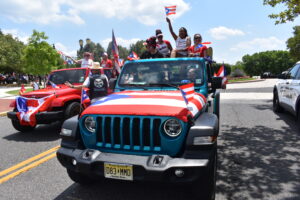Happy Cinco de Mayo — Do You Know What You Are Celebrating?

President George W. Bush recognizes Mexican dancers during a Cinco de Mayo celebration at the White House on May 4, 2001. Photo courtesy of The White House.
BY CLYDE HUGHES | AC JosepH Media
ATLANTIC CITY — While one will find it hard to miss Cinco de Mayo celebrations in South Jersey and around the country — punctuated with Hispanic food specials at restaurants and parties — it is harder to find the true meaning of the holiday and why it is celebrated.
Cinco de Mayo, which is “Fifth of May” in Spanish, annually commemorates Mexico’s surprising victory over the powerful French Empire, led by Napoleon III, at the Battle of Puebla in 1862, which occurred during the U.S. Civil War. The battle helped establish patriotism and nationalism among the Mexican people as they fought against ongoing French influence.
It would take several more years — including significant U.S. intervention after the American Civil War had concluded — to decisively repel the French from Mexico. The Battle of Puebla continued to be remembered as one of the starting points where Mexico began to take its fate into its own hands.
Why Is It More Popular in the United States Than Mexico?
According to Wikipedia, the first Cinco de Mayo honors in the United States can be traced back to Columbia, Calif. in 1862, upon news of the Mexican victory.
Because of its popularity, some have confused Cinco de Mayo with Mexican Independence Day. Sorry, but that holiday is celebrated on Sept. 16 as one of the markers starting Hispanic Heritage Month.
While Mexico often celebrates Cinco de Mayo with military parades and battle reenactments, akin to Memorial and Veterans Day recognitions, Cinco de Mayo became more commercialized in the United States with fiestas and parties. Today, according to Wikipedia, Cinco de Mayo generates beer sales that are only rivaled by the Super Bowl.
Chicano activists in California made big events out of the holiday in the 1960s, connecting the heroism of Indigenous Mexicans over the more powerful and well-funded European invaders in France. The Battle of Puebla became associated with the struggle of Mexican Americans in the United States, according to KRON-TV.
Today, Cinco de Mayo celebrations cross racial and ethnic lines in the United States. The celebrations will be held at bars, restaurants, festivals, and parties around the nation. While some see the multicultural celebration as progress, Indigenous Chicano scholar Ruben A. Arellano, professor of history at California’s Dallas College, was much less generous in his 2022 column in the Washington Post.
“When the Chicano movement dissipated in the 1980s, the holiday slowly became corporatized and commercialized,” Arellano wrote. “The radical politics of the 1960s and ’70s gave way to a more moderate and accommodationist politics.
“By the 1990s, the holiday had been so commercialized and stripped of its original meaning that many people forgot the roots of its initial creation in the mid-19th century and the radical purpose for its revival in the 1960s. What remained was an Anglicized, corporate shell of an event that was once a vehicle through which the Mexican American community could celebrate the triumphs of both its cultural homeland and its newly adopted one.”
Before going to any of Sunday’s gatherings, Priscilla Morales, the Latine Employee Resource Group Co-Lead, at Carnegie Mellon University, asks that people just pause to remember the reason for the day.
“While Cinco de Mayo celebrations in the early- and mid-1900s were centered around celebrating Mexican heritage, over the years festivities have become highly marketed and at times have led to cultural appropriation,” Morales said in 2023 in a human resource article for the university.
“So, this year, please skip the sombrero and overindulgence of margaritas, beers and tacos. Instead, consider ways to engage with Mexican culture year-round such as reading a book, or volunteering with organizations that support not only Mexican individuals but the overall Latine community in Pittsburgh and beyond.”
Follow Us Today On:
Note from AC JosepH Media: If you like this story and others posted on Front Runner New Jersey.com, lend us a hand so we can keep producing articles like these for New Jersey and the world to see. Click on SUPPORT FRNJ and make a contribution that will go directly in making more stories like this available. Thank you for reading.






